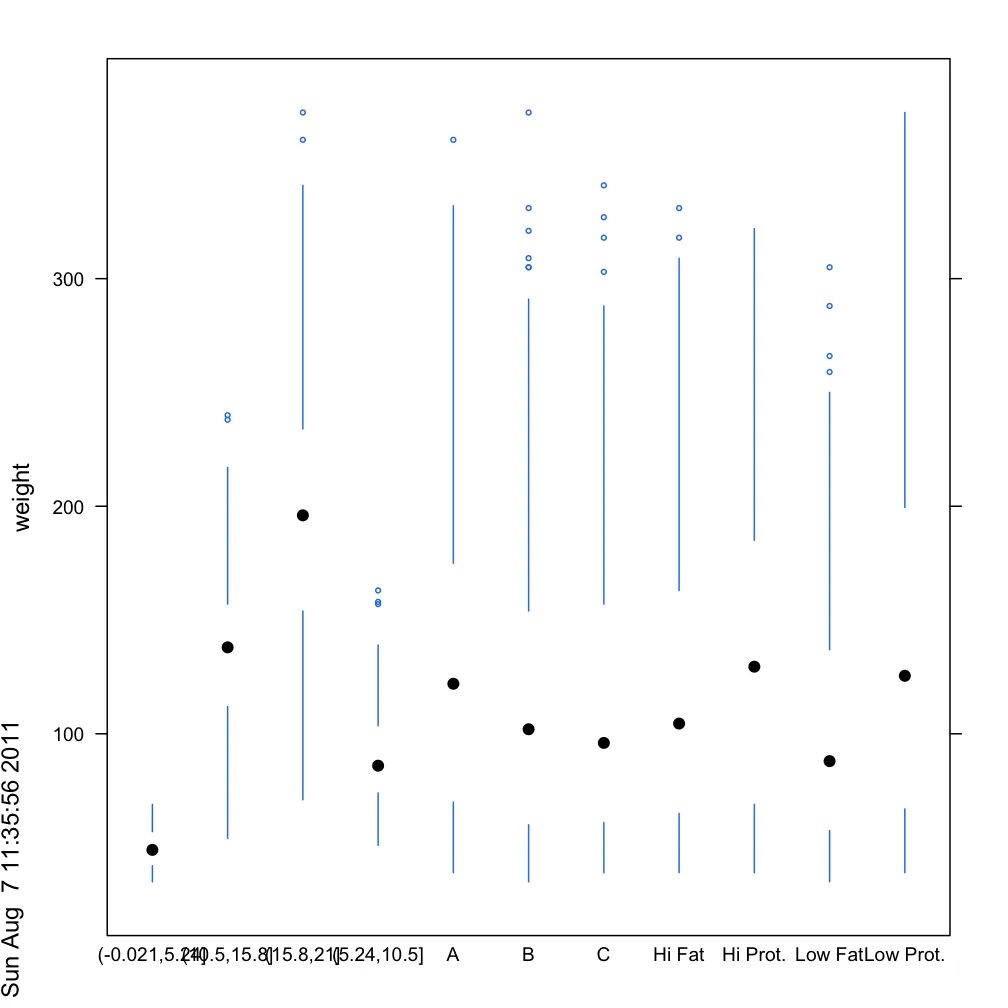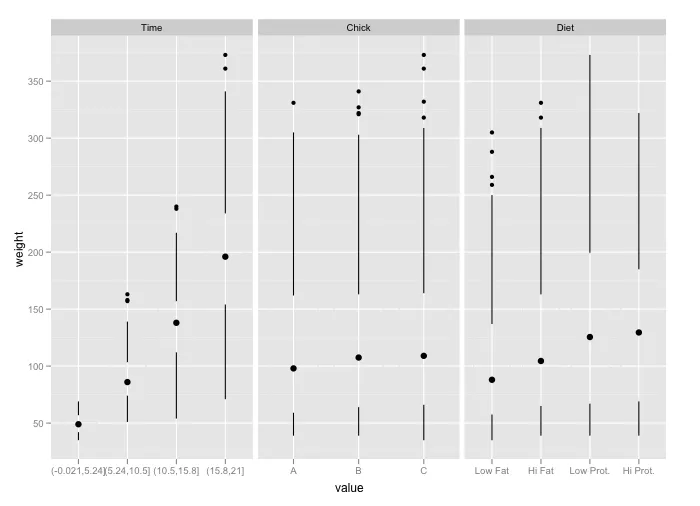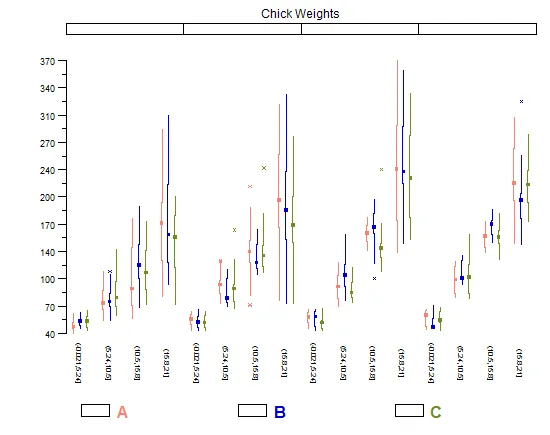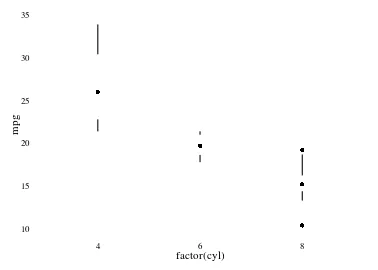您显然只需要一个垂直版本,因此我采用了panel.bwplot代码,剥离了所有非必要的部分,如方框和帽子,并在参数中设置了horizontal=FALSE,并创建了一个panel.tuftebxp函数。还将点的cex设置为默认值的一半。仍有许多选项可以根据您的喜好进行调整。 "Time"的“numeric”因子名称看起来很潦草,但我认为“概念证明”是清晰的,您可以清理重要的内容:
panel.tuftebxp <-
function (x, y, box.ratio = 1, box.width = box.ratio/(1 + box.ratio), horizontal=FALSE,
pch = box.dot$pch, col = box.dot$col,
alpha = box.dot$alpha, cex = box.dot$cex, font = box.dot$font,
fontfamily = box.dot$fontfamily, fontface = box.dot$fontface,
fill = box.rectangle$fill, varwidth = FALSE, notch = FALSE,
notch.frac = 0.5, ..., levels.fos = if (horizontal) sort(unique(y)) else sort(unique(x)),
stats = boxplot.stats, coef = 1.5, do.out = TRUE, identifier = "bwplot")
{
if (all(is.na(x) | is.na(y)))
return()
x <- as.numeric(x)
y <- as.numeric(y)
box.dot <- trellis.par.get("box.dot")
box.rectangle <- trellis.par.get("box.rectangle")
box.umbrella <- trellis.par.get("box.umbrella")
plot.symbol <- trellis.par.get("plot.symbol")
fontsize.points <- trellis.par.get("fontsize")$points
cur.limits <- current.panel.limits()
xscale <- cur.limits$xlim
yscale <- cur.limits$ylim
if (!notch)
notch.frac <- 0
blist <- tapply(y, factor(x, levels = levels.fos), stats,
coef = coef, do.out = do.out)
blist.stats <- t(sapply(blist, "[[", "stats"))
blist.out <- lapply(blist, "[[", "out")
blist.height <- box.width
if (varwidth) {
maxn <- max(table(x))
blist.n <- sapply(blist, "[[", "n")
blist.height <- sqrt(blist.n/maxn) * blist.height
}
blist.conf <- if (notch)
sapply(blist, "[[", "conf")
else t(blist.stats[, c(2, 4), drop = FALSE])
ybnd <- cbind(blist.stats[, 3], blist.conf[2, ], blist.stats[,
4], blist.stats[, 4], blist.conf[2, ], blist.stats[,
3], blist.conf[1, ], blist.stats[, 2], blist.stats[,
2], blist.conf[1, ], blist.stats[, 3])
xleft <- levels.fos - blist.height/2
xright <- levels.fos + blist.height/2
xbnd <- cbind(xleft + notch.frac * blist.height/2, xleft,
xleft, xright, xright, xright - notch.frac * blist.height/2,
xright, xright, xleft, xleft, xleft + notch.frac *
blist.height/2)
xs <- cbind(xbnd, NA_real_)
ys <- cbind(ybnd, NA_real_)
panel.segments(rep(levels.fos, 2), c(blist.stats[, 2],
blist.stats[, 4]), rep(levels.fos, 2), c(blist.stats[,
1], blist.stats[, 5]), col = box.umbrella$col, alpha = box.umbrella$alpha,
lwd = box.umbrella$lwd, lty = box.umbrella$lty, identifier = paste(identifier,
"whisker", sep = "."))
if (all(pch == "|")) {
mult <- if (notch)
1 - notch.frac
else 1
panel.segments(levels.fos - mult * blist.height/2,
blist.stats[, 3], levels.fos + mult * blist.height/2,
blist.stats[, 3], lwd = box.rectangle$lwd, lty = box.rectangle$lty,
col = box.rectangle$col, alpha = alpha, identifier = paste(identifier,
"dot", sep = "."))
}
else {
panel.points(x = levels.fos, y = blist.stats[, 3],
pch = pch, col = col, alpha = alpha, cex = cex,
identifier = paste(identifier,
"dot", sep = "."))
}
panel.points(x = rep(levels.fos, sapply(blist.out, length)),
y = unlist(blist.out), pch = plot.symbol$pch, col = plot.symbol$col,
alpha = plot.symbol$alpha, cex = plot.symbol$cex*0.5,
identifier = paste(identifier, "outlier", sep = "."))
}
bwplot(weight ~ Diet + Time + Chick, data=cw, panel=
function(x,y, ...) panel.tuftebxp(x=x,y=y,...))






